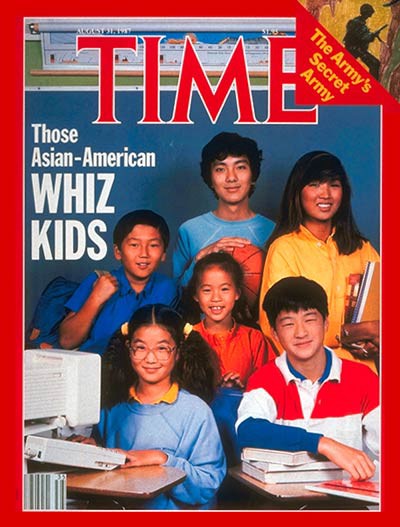Note: As I discuss, the term ?Asian American? is an incredibly broad and heterogenous term. The complexity within this racial category is reflective of US racial formations, which forces people into categories, that do not accurately account for heterogeneity. Another example of this are the terms Latinx/a/o, Chicanx/a/o, and Hispanic, which erases diversity and complexity.
A while back, an Asian American friend was sharing an experience she had in a mostly white space, where some white dude asked if Asian Americans were people of color. As she was telling me this, I laughed and thought where to even begin?
I?ve faced similar questions and experiences. I took a graduate level course in media and gender, sexuality, race, and ability. There were 10+ graduate students and two professors in this class, most of them were white. Weeks into the course, our discussions were fairly mild. While these white women were happy to talk about gender and center their own experiences as white women, conversations around race were much more mild. In fact, they hardly existed. However, during one week, our readings looked at media and Blackness, and the only Black graduate student wasn?t there. As the instructors opened up the class for discussion, I immediately felt the room shift. Suddenly, these white graduate students were talking about Blackness carelessly. Where they once made timid remarks, they were now making racist comments and speaking freely. And it was obvious why. Not only was the one Black graduate student gone that week, but these white graduate students assumed that I was also ?white.? They perceived me and another classmate, two Asian American women, to be closer to whiteness than to Blackness. So when two Asian American women in class called them out, they were shocked. So much so that even the white professors were caught off guard. And instead of critiquing whiteness as part of a conversation that is just as important to race as is Blackness, the class pivoted the conversation and exempted white graduate students of the racism they had just participated in.
These types of experiences are not unique for Asian Americans. We often are faced with moments where other people assume we are not people of color. In fact, many people in our own communities assume that we/they aren?t people of color. And given the myths and lies we?ve been conditioned to live, it?s unsurprising. But there?s an explanation for all of this.
Are Asian Americans people of color?
The short answer is yes.
The long answer is still yes, but Asian Americans are often not perceived as people of color by our peers or ourselves. There are multiple explanations for this. But here, I?ll focus mostly on one ? the model minority narrative, methodically constructed in order to erase the structural, institutional, and historical racism that continues to oppress communities of color.
When we think about Asian Americans today, who and what we largely imagine are model minorities. In other words, we (meaning individual people, society, media, government, institutions, etc) think about Asian Americans as model citizens who symbolize the American Dream ? the idea that one can simply pull oneself up from one?s bootstrap?s through hard-work and determination. Asian Americans are law-abiding, contributing citizens, obedient, hardworking, naturally gifted and smart, trustworthy, and the American success story. And as this mythical model minority narrative becomes circulated and reified, Asian Americans are not seen as people of color. The model minority perpetuates a myth that because of Asian American success (ie: social mobility) and the ?inherent? ability to succeed, they do not, cannot, and have not faced ?real? oppression. Asian Americans are viewed closer to whiteness or at least aspiring to be closer to whiteness.
So what does this all mean? How did we get here?
If the model minority narrative becomes the defining characteristic of Asian American identity, then the vast and complex history of Asian Americans is erased. A history that is riddled with racism, immigration exclusion, discriminatory laws, war atrocities, gross constitutional violations, as well as activism, protest, solidarity ? all of which debunk the model minority myth.
Because I?ll ask this, during segregation, which schools do you think Asian American youth attended?
Origins of ?Model Minority?
The term model minority first became largely popularized by NY Times journalist William Peterson in 1966. However, model minority stereotypes were affiliated with Asian bodies before that. In the 1950s, Korean children/war orphans were seen as in need of saving. During and after the Korean War, many US families adopted Korean war orphans, largely spurred by Christian humanitarianism and American benevolence (Arissa Oh?s ?From War Waif to Ideal Immigrant?). Korean children were seen as ?model citizens? the ideal children to adopt because they would make ideal citizens. Not only did this function to promote American ideologies, such as democracy, during the Cold War, but it also contributed to the erasure of US involvement in the Korean War. The Korean War becomes Forgotten, and the war atrocities with it. For instance, the US used more napalm in Korea than Vietnam, US troops killed and raped women and children, and built camptowns that increased prostitution and sexual violence against Korean women that continue today, and in countless instances, openly gunned down Korean refugees fleeing south towards the 38th Parallel. Yet through the rhetorics of Christian humanitarianism and American benevolence in Korea, the American politic not only forgets what happened in Korea, but also associates qualities of model citizenship with Asian bodies.
In the 1960s, in the backdrop of the American eugenics movement, sociologists attempted to find ?scientific? answers to explain race. As Peterson popularized the idea that Asian Americans were model minorities (specifically over 110,000 Japanese American men, women, and children who were unconstitutionally incarcerated during World War II in US concentration camps), sociologist Daniel Patrick Moynihan tried to explain Black poverty by pointing to inherent flaws in Black families, rather than the structural, institutional, and historical barriers that destroyed Black families, like the lasting legacies of slavery (Moynihan Report 1965). It?s also important to note that sociologists were also looking for innate links between behavior and race ? which is not just highly problematic, but rooted in American eugenics.

Model minority continues to emerge in the media throughout the 1980s, such as the TIME?s, 1987 article cover, ?Whiz Kids.? At the same time, Ronald Reagan adopts economic and political policies, dubbed Reaganomics, that cut social welfare services (that were historically used to help white families ? Ira Katznelson?s When Affirmative Action Was White), leaving individuals to fend for themselves. The rationale here being that the US is a land of opportunity, where anyone can succeed as long as they work hard enough. On one hand, if an individual succeeds, it?s based on their hard work and merit. On the other, if they fail, it?s because of their own individual flaws. And what other racial group can prove this American mythology to be true than Asian Americans? If Asian Americans can pull themselves up from their own bootstraps, why can?t anyone else?
Racial stereotypes were created and utilized to explain individual and group behaviors. For instance, Black families suffered from poverty because they were lazy. Black people were incarcerated at disproportionate rates because they were inherently criminal and violent. Latinos were hard working, but lacked intelligence. And Asians were successful because they were naturally intelligent and genetically-engineered to be hard-working.
So what happens then when race becomes conflated with stereotypes? We then see race as biological rather than socially constructed. We see race and characteristics affiliated with different races as synonymous with one another. We then see those characteristics as inherent to the individual, a genetic code that predetermines someone, and a group?s, future. We create generalizations that explain a racial group?s failure, rather than addressing the very real systemic, institutional, and cultural barriers put into place. If this sounds familiar, it?s because this is also known as eugenics.
And what we don?t see is how race is a concept that has always changed. It is dynamic, malleable, and only meaningful because we give it meaning. For instance, we now consider many European ethnic groups as white. But in the early 1900s, Irish, Italian, and Eastern European immigrants weren?t seen as, and inferior to, whites.
What we don?t see is how certain groups face higher rates of unemployment, homelessness, incarceration, and lack of social mobility, not because of their individual flaws, but because the systems and institutions are flawed. After all, if a country is founded upon genocide and slavery, and only sees white men as citizens (all others are asterisked into the process later), don?t groups who are ?Other-ed? have a lot of catching up to do?
It is not about hard work, effort, or merit. It is about resources, wealth, and how much you start off with, and even then, that does not offer security for Black families. It is about the odds that are stacked for or against you.
Explaining Model Minority Success
So how do Asian Americans fit into all of this? If Asians/Asian Americans were victims of racism, coolie labor, indentured servitude, US imperialism, immigration exclusion, and more, how do we explain Asian American success?
First. The statement that Asian Americans face higher rates of socioeconomic mobility overlooks one VERY important fact. That within the heterogeneous category of Asian American exists groups who face high rates of unemployment, incarceration, and poverty. Asian American is a category that has the impossible task of including and remembering everyone. While Chinese, Japanese, and Korean Americans are largely remembered, we forget that this category also includes Filipinos, South Asians, Southeast Asians, as well as Pacific Islanders, and all of this is messy, complex, and constantly changing.
Second, we need not look further than immigration history.
There are two historical moments in the US where there was mass migration from Asia. The first was in the late 1800s with large Chinese, Japanese, and Indian migrations. But in 1924, immigration from Asia was effectively banned through the 1924 Immigration Act, also known as the Asian Exclusion Act. (Between 1882 to 1924, various laws banned different groups from Asia, the first being the 1882 Chinese Exclusion Act.) The 1924 Immigration Act reinforced the Asiatic Barred Zone, an area drafted in 1917 that extended from the now Middle East, to South Asia, to parts of East Asia. The only countries exempt in the Asiatic Barred Zone were Japan and the Philippines, but the 1924 Immigration Act later banned immigration from Japan. The Philippines were exempt because they were a US colony at the time and were thus seen as US Nationals ? neither foreigners, nor citizens.
Note: Alien Land Laws prevented non-citizens from owning property. And because of hypocritical and racist US citizenship/naturalization laws, Asian immigrants could not legally become citizens. Only their children who were born in the US were considered citizens, and thereby eligible to own property. In Southern California, communities of South Asian/Mexican families flourished. South Asian men married Mexican women, where the women held property titles for the family since they were legally considered white and could hold property. To learn more.
Immigration exclusion was in effect until 1965. Prompted by Cold War ideologies, to show the world that democracy was better than communism, the US opened immigration using the following two criteria, 1. Family reunification, and 2. Skilled laborers. However, lawmakers intended to use these two justifications to increase immigration from Europe, while limiting immigration from the formerly Asiatic Barred Zone. They figured that because mass immigration from that area had been banned for over 40 years, family reunification would self select certain groups. They saw people from Iran to Korea as inferior and coming from ?third world countries,? and thus assumed many would not qualify under the skilled laborer visa clause, unlike their European, western counterparts. Obviously, they were wrong.
1965 is an important moment to observe in Asian American history because it brings in a new generation of Asian immigrants, adding to the already established communities of those who came before 1924. (An aside, growing up I always wondered why most of my Korean, Chinese, Vietnamese, South Asian and Persian friends were 2nd generation, whose parents immigrated to the US, whereas most of my Japanese friends were 4th generation, whose grandparents were fluent in English. The answer, immigration laws.)
Many who came through the 1965 Immigration Act were coming from a relative place of advantage. That?s not to diminish the hardships they endured while in the US. Rather, it is to point out that immigrants who came through the 1965 Immigration Act were doing so under conditions separate from slavery, unskilled labor, coolie labor, indentured servitude, temporary day labor, etc.
At the same time, after the Vietnam War ends with the Fall of Saigon in 1975, the US passes the 1980 Refugee Act, helping secure permanent admission for refugees (caused by US and Soviet imperialism overseas). The US wars in Vietnam, Laos, and Cambodia, created large refugee populations who would resettle in the US ? Vietnamese, Laotian, Cambodian, Hmong. So for many Southeast Asians, their arrival to the US was prompted by war and refugee status, and not through the former visa requirements.
And so while many East Asian Americans experience socioeconomic mobility and ?success,? many Southeast Asian Americans experience high rates of poverty, incarceration, homelessness, and lack of mobility. Another example of this is Cuban immigration ? those who came before the 1950s and experienced socioeconomic success, and those who came after 1959, fleeing Fidel Castro?s rule and have lower educational and economic achievement than the former group.
The term Asian American has become conflated with the term model minority. Asian Americans are not inherently predisposed to success, hard-work, or intelligence. These are dangerous stereotypes that easily become adopted as a part of eugenics narratives. Rather, there are historical, structural, and institutional conditions and explanations that have predisposed SOME groups of Asian Americans towards success.
The model minority is integral to American ideologies and mythologies.
Because Asian American success can then be used to explain everyone else?s failures. Model minority is a myth that is used to falsely justify WHY every other non-white racial group is ?underachieving.? The model minority myth explains why these groups are killed by police, incarcerated en masse, face higher dropout rates, unemployment, and homelessness. The model minority myth points to individual flaws, exempting structure, history, and institutions, while also ignoring that within the category of Asian American itself, groups face high rates of ?failures,? as well.
The model minority myth erases the complexity of Asian American identities and issues plaguing many Asian American communities. The model minority myth upholds American myths and ideologies, leaving us to continue to believe that the US is a land of freedom and opportunity.
And this is just the tip of the iceberg.


